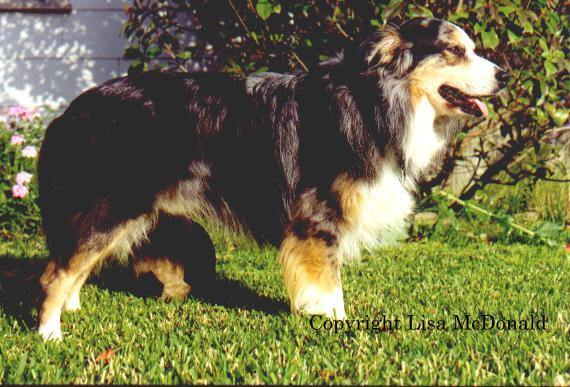
The action of the merle gene randomly dilutes black areas yielding a dog with a blue and black patchwork pattern as individual as a fingerprint. The same is true of red merles. There is considerable variation among the merles in the amount and darkness of the blue areas. Some have a dilute spot or two. It would appear that there are modifying genes that affect how much blue is present. British breeders of Rough Collies have successfully selected for blue merles that are nearly all blue with very little black. In Aussies there has been little if any selection for more or less blue coverage, so many litters contain a variety. Sometimes a blue merle is overall muddy, brownish, or has a reddish dilute spot. There is no way to tell by looking if he's a red carrier, and these features are not an indication of carrier status. The red allele is not known to exist in the Rough Collie gene pool, and breeders of blue merle Rough Collies have to deal with the same off blue hues and dilute spots. Ideally a blue merle has an undercoat the same color as the guard hairs. Some have tan or buff colored undercoats, rendering an overall muddy appearance. Here are some examples of the variation seen in blue merles.

Las Rocosa Top Gun Silverwing "Gunner" is a typical blue merle. He shows the Irish spotting pattern with plus modifiers. These modifiers reduce the coverage of the white. He has no dilute spots and his blue areas are a dark pewter. As with many but not all merles, he has darkened with age from a very light bright blue puppy. He has modest ticking. His probable genotype is (at at Bb kk Mm sisi).
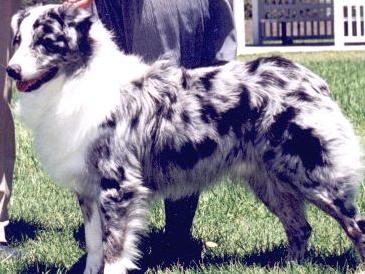
This is Riot, photo courtesy of Mary Hawley (Windsor Australian Shepherds). He has no tan points at all, but he does have generous white trim in the Irish spotting pattern. He would be called a blue merle and white. He is not a self merle, since he does have white trim. His probable genotype is (atat B- K- Mm sisi). Most Aussies are at at at the A locus according to Healthgene, so he probably has at least one copy of K suppressing the formation of tan points.
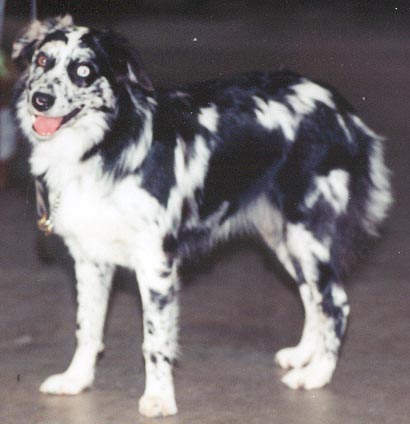
This is Fairoaks Isis, a gorgeous blue merle and white. Her merle areas are very pale, reminding one of a glacier. She also appears to have ticking on her front legs. Compared to Riot her black areas show heavier marbling. Her probable genotype is also (atat B- K- Mm sisi).

This lovely blue merle would be correctly called blue merle with tan points. No white markings are visible. The blue is very rich and the tan points a deep, rich rust. This photo was sent to me, and I have misplaced the name of the owner/photographer. I would be glad to credit the owner and/or photographer. The probable genotype is (atat B- kk Mm S-). We know kbr isn't present, or she'd have brindle on the tan points. If K were present she would not have the tan point pattern.
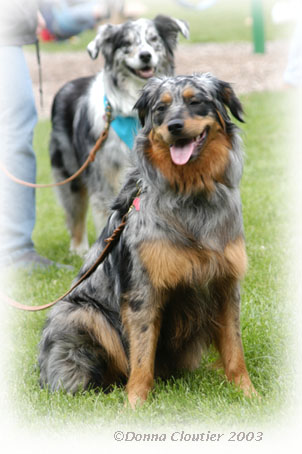
This beautiful girl is Bindi, photo courtesy of Donna Cloutier. She is a blue merle with tan points and no white. If she were not a merle, she'd be a black and tan. She does not show evidence of having inherited a white spotting pattern. Though less common than Aussies with the Irish spotting pattern typical of collie type breeds, absence of white is perfectly acceptable in the Aussie standard. Her probable genotype is (at at B- kk Mm S-).
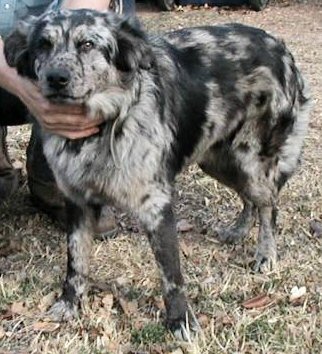
This handsome guy is Mike, a self blue merle (photo courtesy of Steffany Jay). He has no white markings, not even a white toe! He also does not have the tan point pattern. If not for the merle gene he would be solid black. His probable genotype is (at at B- K- Mm S-). He may have the gene for ticking, but since he has no white there is nowhere for it show up if it is present. Self merles are more common in working lines where there has not been heavy selection for white trim.
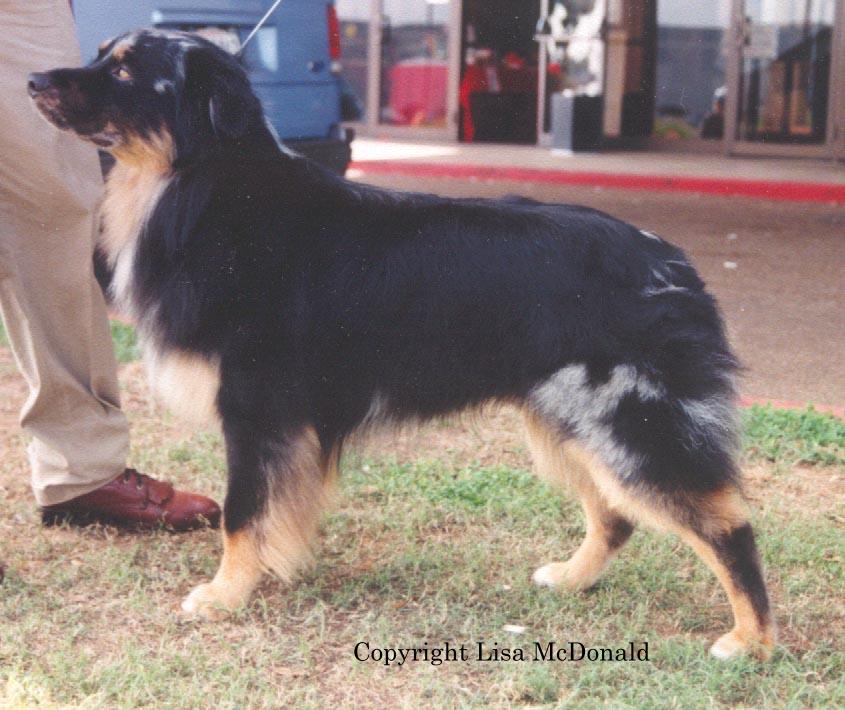
Las Animas Jack of Diamonds "Blue" also shows minimal merling on his left side. There is a bit more blue on his right side, where his merling is heavier. The amount of merling is not always the same on both sides of the dog. He shows the Irish spotting pattern heavily affected by plus modifiers; it is reduced in expression to white feet, a white chest, and some white on his neck. His probable genotype is (at- B- kk Mm si-).
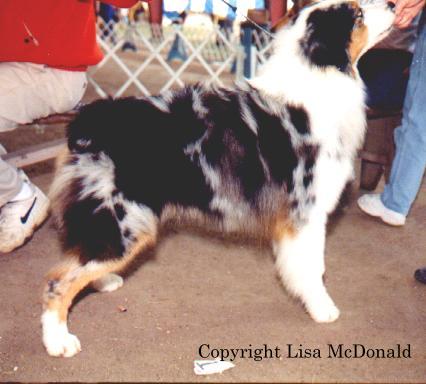
This 9-12 month old male puppy Reverie Raconteur "Randall" shows heavier merling than "Blue". His merled areas are lighter and his black areas look like rich marbling. He also has several distinct dilute patches on his rib cage. He has a full expression of the Irish Spotting pattern. His probable genotype is (atat B- kk Mm si -).

Mouse (photo courtesy Shelley Hollen) has tiny distinct spots like a cheetah rather than heavy black marbling. The expression of the merle gene is as individual as fingerprints from dog to dog. Collie breeders have shown us that it is possible by selective breeding of merles to merles to deliberately produce less and less black, to the point that the dog may have only a small black spot and be silvery blue everywhere else. Presumably the reverse is also true, where one could breed for minimal expression of the merling. So far no one in Aussies has done this systematically like the collie breeders have, so even within a single litter there can be quite a bit of variation.
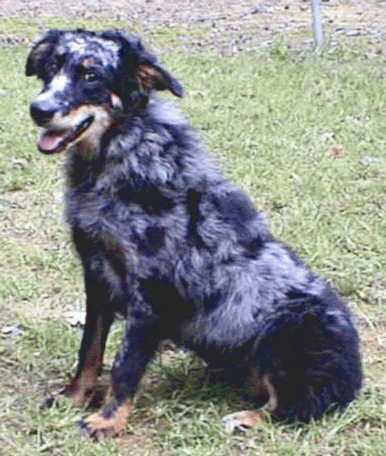
Some merles darken with age, some do not. Some, like Filly here, are very dark from the start (photo courtesy Kristy Klein). Filly is only a year old, yet she is as dark as some merles that are 10 years old or more. There is considerable variation in blue (or red) saturation. Time will tell whether Filly will darken further and resemble a black tri as the contrast decreases between blue and black areas.
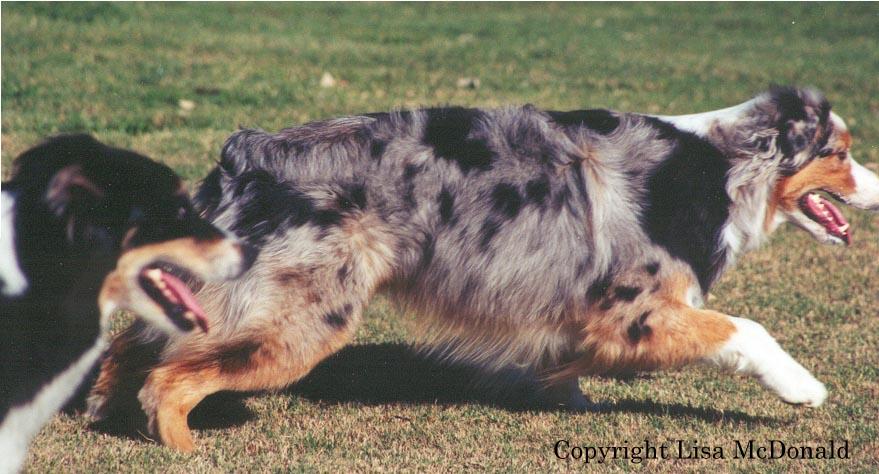
Tanner, Mary Fillerup's Heartfire boy, shows a more leopardlike merle pattern; his black areas are similar in size and somewhat evenly spaced. He also has tan points that are quite extensive and overlap the body color a little. Note the running copper on his knee and elbow. He is in hot pursuit of a basketball with pal Cookie close behind.
© 1999-2009 Lisa McDonald Comments